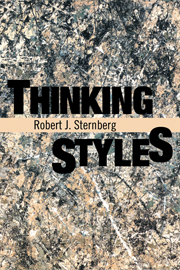Book contents
- Frontmatter
- Contents
- Preface
- Part I The Nature of Thinking Styles
- 1 What Are Thinking Styles and Why Do We Need Them?
- 2 Functions of Thinking Styles: The Legislative, Executive, and Judicial Styles
- 3 Forms of Thinking Styles: The Monarchic, Hierarchic, Oligarchic, and Anarchic Styles
- 4 Levels, Scope, and Leanings of Thinking Styles: The Global, Local, Internal, External, Liberal, and Conservative Styles
- Part II The Principles and Development of Thinking Styles
- Part III Thinking Styles in School and in Research and Theory
- Notes
- Index
1 - What Are Thinking Styles and Why Do We Need Them?
Published online by Cambridge University Press: 05 August 2012
- Frontmatter
- Contents
- Preface
- Part I The Nature of Thinking Styles
- 1 What Are Thinking Styles and Why Do We Need Them?
- 2 Functions of Thinking Styles: The Legislative, Executive, and Judicial Styles
- 3 Forms of Thinking Styles: The Monarchic, Hierarchic, Oligarchic, and Anarchic Styles
- 4 Levels, Scope, and Leanings of Thinking Styles: The Global, Local, Internal, External, Liberal, and Conservative Styles
- Part II The Principles and Development of Thinking Styles
- Part III Thinking Styles in School and in Research and Theory
- Notes
- Index
Summary
When Susan was in the third grade, her teacher had a neat idea. The children were studying the planets, and the teacher wanted her students to learn actively, not just passively. So she decided to have the children pretend to be astronauts, and simulate going to Mars.
PENALIZING PEOPLE WHO DON'T FIT IN
This idea was a good one for promoting learning. What better way is there to learn about a place than to simulate being there, whether it be Mars, Venice, or Hoboken, for that matter? Here, the children would have to think about the air supply, the gravity, the terrain, and anything else that a visitor to Mars would have to consider. Of course, the children could learn all these things by reading about them. But their learning and their retention would certainly be enhanced by pretending to deal with them at first hand. However, they would have to know enough about Mars to be able to imagine being there. Reading would give the children an additional way to learn, and thus further enhance the learning process. But it could never be a substitute for the children's actively putting themselves in the place of astronauts.
As the children were preparing to be astronauts, Susan had an idea. How about if she dressed up as a Martian, and met the astronauts when they arrived on Mars? The teacher's idea was good, but perhaps Susan's was even better.
Information
- Type
- Chapter
- Information
- Thinking Styles , pp. 3 - 26Publisher: Cambridge University PressPrint publication year: 1997
Accessibility standard: Unknown
Why this information is here
This section outlines the accessibility features of this content - including support for screen readers, full keyboard navigation and high-contrast display options. This may not be relevant for you.Accessibility Information
- 2
- Cited by
